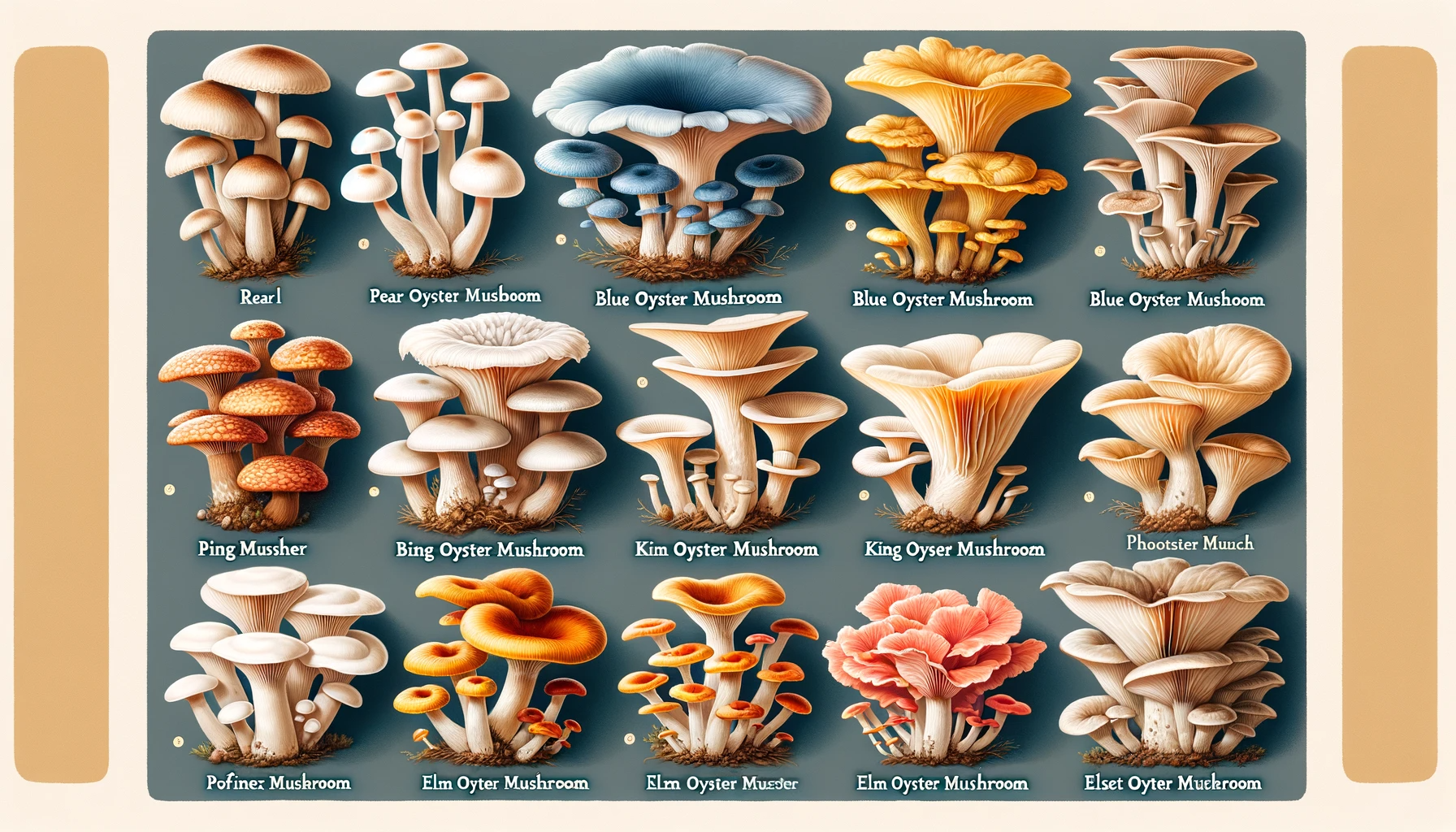Oyster mushrooms, or Pleurotus ostreatus, are a fascinating and versatile species of edible fungi, cherished for their unique flavor and texture, as well as their numerous health benefits. Here, we delve deeper into their characteristics, culinary uses, types, and medicinal properties.
Nutritional Profile and Health Benefits
Oyster mushrooms are a powerhouse of nutrition. They are low in calories yet rich in protein, fiber, and essential nutrients. Key nutritional aspects include:
- Protein Content: These mushrooms are an excellent source of high-quality protein, which is particularly important in vegetarian and vegan diets.
- Vitamins and Minerals: They are rich in B vitamins, especially niacin and riboflavin, and provide a good source of vitamin D when exposed to sunlight. Minerals like potassium, iron, and phosphorus are abundantly present.
- Antioxidants: Oyster mushrooms contain antioxidants like selenium, which help in combating oxidative stress and reducing inflammation in the body.
These nutritional elements contribute to various health benefits, such as improving heart health, managing diabetes, and supporting immune function.
Culinary Uses
Oyster mushrooms are highly versatile in culinary applications. They have a subtle flavor that pairs well with numerous ingredients and can be cooked in various ways:
- Cooking Techniques: They can be sautéed, grilled, baked, or stir-fried. They are popular in Asian stir-fries, soups, and vegetarian dishes.
- Flavor Pairings: These mushrooms pair well with garlic, soy sauce, onions, leeks, and fresh herbs like thyme and parsley. They also complement creamy sauces and can be a great addition to risotto and pasta dishes.
Types of Oyster Mushrooms
Oyster mushrooms are not only diverse in their culinary uses but also in their species and varieties. Each type of oyster mushroom has unique characteristics, flavors, and textures, making them suitable for different culinary applications.
1. Pearl Oyster Mushroom (Pleurotus ostreatus)
- Appearance: Typically white to light brown caps with a smooth, oyster or fan-shaped appearance.
- Texture and Flavor: They have a delicate, tender texture with a mild, slightly woody flavor.
- Culinary Uses: Ideal for light dishes like soups, salads, and lightly sautéed dishes.
2. Blue Oyster Mushroom (Pleurotus columbinus)
- Appearance: Noted for their striking blue to gray caps, which become more grey as they mature.
- Texture and Flavor: These mushrooms have a firm, slightly chewy texture and a flavor that is more robust than the pearl variety.
- Culinary Uses: Excellent in stir-fries, grilled dishes, and any recipe where a firmer texture is desired.
3. Golden Oyster Mushroom (Pleurotus citrinopileatus)
- Appearance: Vibrant yellow to gold caps, making them visually distinctive.
- Texture and Flavor: They are slightly crunchy with a nutty, somewhat peppery taste.
- Culinary Uses: Great in Asian cuisine, especially in dishes where their bright color and peppery flavor can stand out.
4. Pink Oyster Mushroom (Pleurotus djamor)
- Appearance: These are easily recognizable by their bright pink color, though the color fades when cooked.
- Texture and Flavor: They have a woody and earthy flavor, with a meaty texture.
- Culinary Uses: Best used in hearty dishes like stews, roasts, or any recipe that requires a robust flavor.
5. King Oyster Mushroom (Pleurotus eryngii)
- Appearance: Distinctive for their long, thick stems and smaller tan caps.
- Texture and Flavor: They have a meaty texture and savory, umami flavor, making them a popular meat substitute.
- Culinary Uses: Excellent when sliced and grilled, sautéed, or used in place of meat in various dishes.
6. Phoenix Oyster Mushroom (Pleurotus pulmonarius)
- Appearance: Similar to the pearl oyster but with a paler color and smaller caps.
- Texture and Flavor: They offer a delicate texture with a slightly more pronounced flavor than the pearl oyster.
- Culinary Uses: Versatile in various culinary applications, particularly in light pasta dishes and as a topping for pizzas.
7. Elm Oyster Mushroom (Hypsizygus ulmarius)
- Appearance: These have a more rounded cap and are usually white to light brown.
- Texture and Flavor: The texture is firm, and the flavor is mild, similar to the pearl oyster but slightly sweeter.
- Culinary Uses: They are versatile in cooking, and suitable for frying, baking, and adding to soups or stews.
8. Scarlet Oyster Mushroom (Pleurotus coccineus)
- Appearance: Notable for their bright red to orange caps, a unique color among oyster mushrooms.
- Texture and Flavor: They have a tender texture and a slightly fruity flavor.
- Culinary Uses: Best used in dishes where their vibrant color and unique flavor can be showcased, like in salads or as garnishes.
Cultivation and Environmental Impact
Oyster mushrooms are not only popular in the kitchen but also for their ease of cultivation and environmental benefits:
- Growing Conditions: They can grow on various substrates, including straw, wood, and agricultural byproducts, making them a sustainable choice.
- Environmental Benefits: By decomposing organic matter, they play a crucial role in nutrient recycling and soil health.
Medicinal Benefits
Beyond their culinary appeal, oyster mushrooms have been recognized for their therapeutic properties, More details on this study can be found at PubMed.
- Cholesterol Management: Contains statins, which may help in reducing cholesterol levels.
- Immune Support: Some studies suggest that they can boost immune system function.
Conclusion
Each type of oyster mushroom brings its unique qualities to the table, both in terms of aesthetics and culinary attributes. Whether you are a gourmet chef or a home cook, experimenting with these different types can add a new dimension to your dishes, offering a range of flavors, textures, and colors to play with. Additionally, their varied nutritional profiles make them a healthy and delicious addition to any meal.
FAQs
Q1: Can I forage for oyster mushrooms in the wild?
A1: Yes, but you must be able to accurately identify them, as some wild mushrooms can be toxic. It’s always safer to buy them from a trusted source or grow them yourself.
Q2: How do I store oyster mushrooms?
A2: They should be stored in a paper bag in the refrigerator and used within a week for optimal freshness.
Q3: Are oyster mushrooms suitable for allergy sufferers?
A3: Generally, yes, but it’s always best to consult with a healthcare provider if you have specific food allergies.
Q4: Can I grow oyster mushrooms at home?
A4: Absolutely! Oyster mushrooms are one of the easiest mushrooms to cultivate at home using mushroom growing kits or DIY methods with straw or coffee grounds.
Q5: Do oyster mushrooms have medicinal uses?
A5: Yes, they have been studied for their potential to lower cholesterol, support immune function, and provide antioxidant benefits.

Alex is a seasoned writer and researcher, specializing in psychedelic studies and mental health. Known for insightful and authoritative content, he combines extensive knowledge with a passion for exploring wellness and alternative therapies. Alex’s work is a trusted resource for readers delving into the world of mental well-being.


Leave a Reply